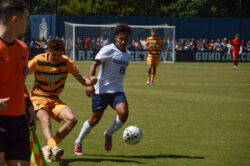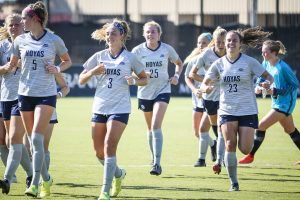Scoring a game-winning goal in a professional soccer game is something many young players dream of, but getting onto a stage that large and rising to the occasion is a position only the most elite get a chance to be in.
So it was a momentous occasion when, at just 13, forward McKenna Whitham scored a preseason game-winning goal for NJ/NY Gotham FC of the National Women’s Soccer League (NWSL). With that play, Whitham simultaneously became the youngest player to ever score a goal in a NWSL match, and the youngest person to ever play for a NWSL team.
For a child—someone who is not yet old enough to drive a car, vote in elections, or even work a part-time job—having the sort of skill and poise required to make a shot like that is deeply impressive. There is no doubt that Whitham is shaping up to be a genuine prodigy and a spectacular player.
However, Whitham’s accomplishment also sparks concern about the extent to which minors should be allowed to participate in the world of professional athletics. As a result of children and teens more frequently striving for greatness, there have been debates among physicians, coaches, and even players themselves about whether sports are becoming too intense, too competitive, and even too dangerous for them.
When it comes to physical health, the problem isn’t just the sheer number of hours being spent participating in sports, but also what kind of sports they’re playing. Studies have shown that when youth participate in just one sport, especially when they spend a great deal of time practicing, it significantly increases their risk of serious injury. Injuries due to overuse have become increasingly common over the past few years, now amounting to “half of the injuries seen in young athletes,” per the American Orthopaedic Society for Sports Medicine.
Thus, physicians generally recommend that young athletes play several sports; this allows for their muscles, tendons, ligaments, and bones to work in a more well-rounded and sustainable way. The challenge with this approach lies in the fact that diversification doesn’t lend itself well to elite success at a young age.
For young athletes to achieve the sorts of accomplishments that Whitham had in the Gotham game, they have to train very seriously from a very young age. As with anything else, becoming genuinely great at soccer requires an immense amount of focus and dedication. To devote that sort of time to a singular sport, most other things—including other athletic pursuits—will almost always fall by the wayside. When young players decide to take a sport seriously, especially as they grow older and get closer to the age of college scholarship offers, players often transition towards playing year-round, often combining school teams, rec leagues, and travel clubs that tend to skew towards being quite competitive and intense.
Thus, there’s a baseline physical risk to a 13-year-old playing professional soccer, because of the degree of specialization required to get to the pros in the first place. And in addition to physical health, the mental strain of playing at the elite and professional levels could pose problems for players’ mental health.
Generally speaking, studies have shown that participating in sports can improve kids’ mental health; athletic participation has been linked to better communication skills and a greater ability to regulate emotions in a healthy manner. That benefit doesn’t necessarily extend to elite youth sports, though, as such a high-intensity environment can very easily become a pressure cooker of expectations and stress. And this sort of pressure only builds as time goes on and players move up in the ranks, with older high schoolers and college athletes often facing immense scrutiny from fans, coaches, and scouts.
Now imagine being a teenager playing not at an elite youth level, but a professional one. When Whitham took the pitch, she was the youngest player on the team by eight years, and she did so with the game on the line. She’s got an NIL deal with Nike—the company’s youngest signed athlete—and an Instagram following in the thousands. Whitham isn’t the biggest name out there, but she’s far from a typical teenager.
And there’s nothing wrong with that. But that’s a lot of pressure to perform, to excel, to achieve. The situation feels less about Whitham’s capabilities as an athlete and more about what 13-year-olds, regardless of skill level, should be allowed to undertake.
There are a couple of other important caveats here as well. Whitham isn’t listed on Gotham’s official roster. Based on comments from her parents and ESPN reports, she’s been working out and practicing with NWSL teams while also homeschooling and playing for a local travel team. Of course, this is a substantial workload, but it’s not the same as letting a 13-year-old ink a legitimate professional contact before she’s even finished middle school.
Additionally, there is a bit of precedent for this sort of situation. Olivia Moultrie, who currently plays for the Portland Thorns, joined the team at 13. However, she was not allowed to sign a professional contract at the time because of her age—something she would go on to sue the NWSL for. Eventually, after winning that suit, she started playing with the senior team at the age of 15.
Moultrie’s legal victory and subsequent on-pitch success have opened the floodgates for more girls to follow in her footsteps. One of those is Whitham, who has already made history of her own. But these choices, as exciting and inspiring as they seem on the surface, could have potentially serious ramifications. It will be up to time—and the kids who have climbed into the big leagues—to determine whether or not they were making the right call.





